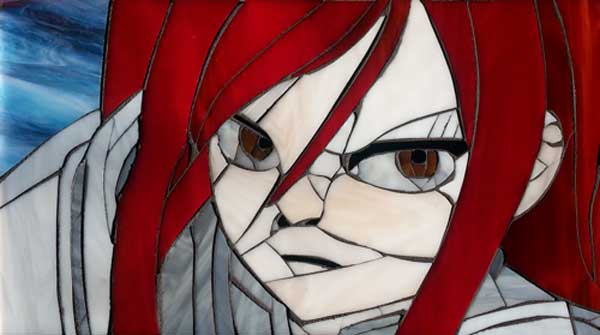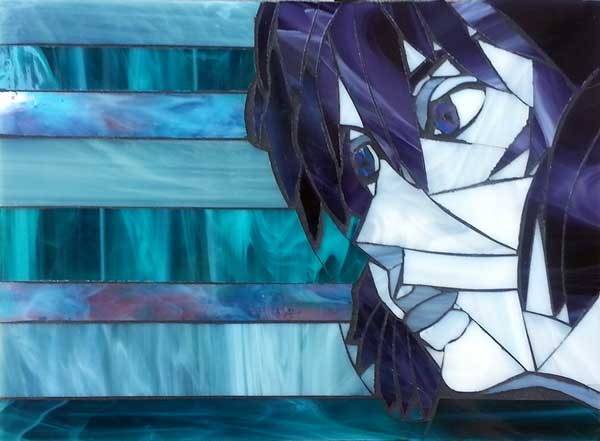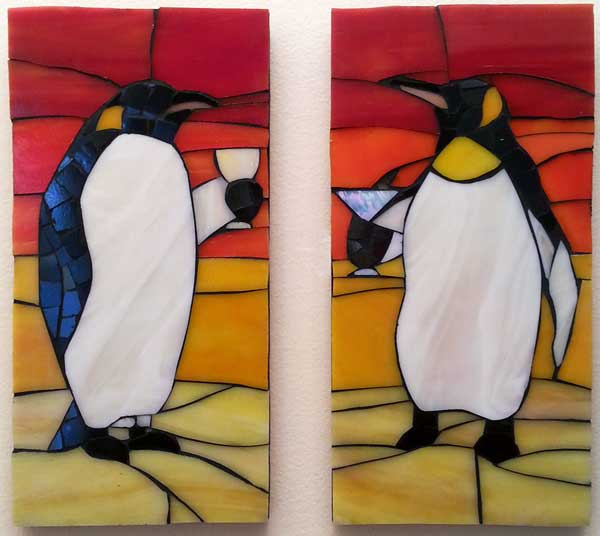Artist and MAS employee Natalija Moss has recently completed a series of mosaics made from stained glass, and they are definitely worth seeing and discussing for several reasons. Natalija’s other artwork and video game plugins can be seen at her Lady Natalya website.

Stained glass can be used in mosaic artwork in two different ways. The stained glass can be cut up into small tesserae (pieces) just like glass mosaic tile in a typical mosaic approach, or it can be used in larger pieces similar to how it is used in stained glass artwork. This latter approach preserves the large swirls of color which cutting into smaller pieces tends to break up, and this allows “the glass to do the work” as stained glass artists often say as a maxim. What they mean by that expression is allowing the swirls in the stained glass to create visual interest and suggest details such as ripples in water instead of rendering each ripple individually as a separate piece of glass.
I tend to think of mosaic artwork in terms of the traditional mosaic approach and cut any stained glass I use into tiny tiles, but I was impressed by how successful Natalija’s mosaics were and how conspicuously different they were from my preconceptions.
Compare Natalija’s “Erza” mosaic to Doug and Carly’s “Van Gogh Self Portrait” mosaic. Notice how the flowing andamento so crucial to the the Van Gogh mosaic is COMPLETELY absent in Natalija’s work.

On reflection, I can see that Natalija’s use of stained glass in larger pieces instead of many small tesserae is merely stained glass artwork as stained glass artwork is typically done, but there are two reasons that Natalija’s work still stands out. First, she didn’t give up the stained glass convention of larger piece sizes merely because she was mounting on an opaque background to make a mosaic.
The second reason Natalija’s work caught my notice was the freshness of her themes/subjects. As a rule, stained glass artwork tends to use some of the most cliche designs to be found in art and crafts marketing (which is saying quite a bit), so Natalija’s use of subjects from Japanimation is fairly novel for that medium. I think that grabbed my attention as much as the absence of andamento.

A Digression On The Failings of Stained Glass Retailers
It has been very easy for me to ignore stained glass artwork for the most part in the 13+ years I have been running Mosaic Art Supply because so much of it I came across by chance was so cliche and dated. The butterflies, bald eagles and tulips you see so much of now in stained glass catalogs appear to be the exact same patterns I saw 15 years ago and as a boy in the 1970’s.
I think the people who sell stained glass have done a disservice to their customers and to their own wallets by promoting their industry in such a tired way. Sure, there will always be people who want sappy stuff because they like sappy stuff or think it is easier to make, but I think that sort of approach tends to kill interest in the medium over time by not attracting younger people and people with more serious interests in art. This converging on the cliche by stained glass marketers has also meant that their patterns were more easily mass produced by countless Chinese competitors, which further destroys profit margins as everyone “races to the bottom” to compete solely on lowest price.
All of my product decisions at Mosaic Art Supply were made with one eye toward avoiding these traps, and this is why we have always avoided selling the mosaic craft kits we see on the market. I want to promote a serious interest in Art with a capital A because I think it is in the best interest of my industry, and because if I wanted to help distribute mass-produced junk, I could have stayed in the corporate world. In the sense of being something a person creates for deeply personal reasons, Art is one of the few intrinsically sacred things in a world where everything is increasingly profaned and commercialized. That is why the prevalence of cliche stained glass patterns has always struck me as being nothing less than a tragedy, a huge opportunity lost. Even if you prefer those particular subjects/themes, it should still strike you as conspicuously strange that you don’t often see alternatives to those themes being offered as patterns by stained glass retailers.


Leave a Reply